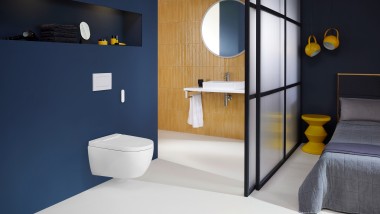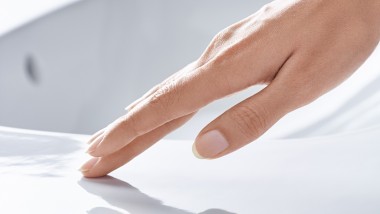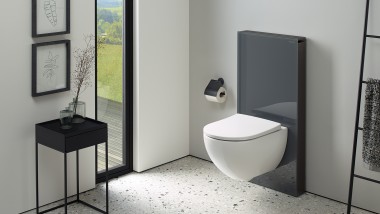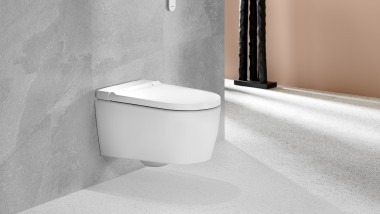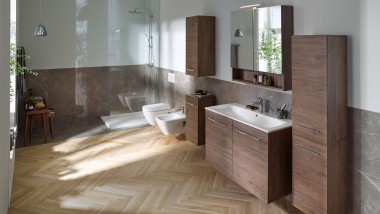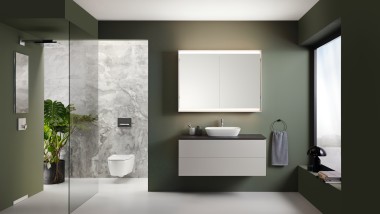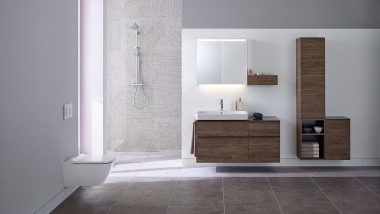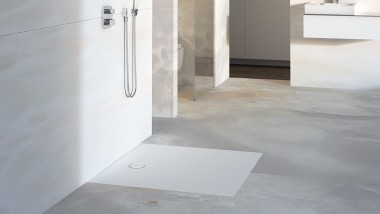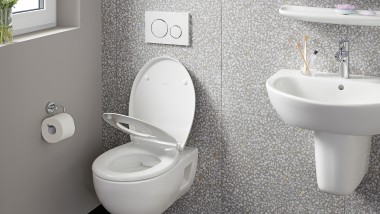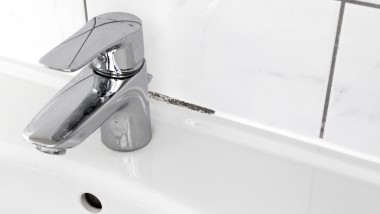Toilet cleaning made easy
Regular cleaning of the toilet is not only critically important for maintaining an appealing bathroom, but also for your health as well. From removing stubborn deposits to regular care of the toilet brush and cistern, we have some useful tips for keeping your toilet in perfect condition.
Why is regular toilet cleaning important?
Dirt accumulates around the toilet area. Deposits build up here, particularly in hard-to-reach places such as the toilet rim. By cleaning the toilet regularly, you can effectively prevent dirt and soiling.
A clean toilet and a fresh smell both make a significant contribution to a pleasant atmosphere in the room.
Step by step to a clean toilet
While cleaning the toilet is one of the more unpopular household chores, it is absolutely essential for ensuring a hygienic bathroom. It is important to note that microorganisms can be transported from one surface to another via cleaning cloths or sponges.
Therefore, different cleaning cloths should be used for cleaning the toilet and other areas of the bathroom. Microfibre cloths in various colours can be differentiated well and can be washed at up to 60 degrees Celsius.
We also recommend the following:
- Wear gloves and protective goggles to protect the skin and eyes.
- Ventilate well during the cleaning process.
- Test cleaning products before using them on sensitive surfaces such as marble and other natural stone.
- Rimless toilets with innovative functions keep cleaning to a minimum. Due to the open design, there are fewer places for dirt to build up and removal is also easier.
Cleaning the WC seat
Cleaning the WC seat is just as important as cleaning the toilet itself. When cleaning the WC seat, use a mild cleaning agent and a soft, lint-free cloth in order to prevent surface scratches.
A removable WC seat is practical, as it can be removed quickly thanks to the quick-release system and cleaned more thoroughly.
Natural and chemical cleaning agents
Both natural and chemical cleaning agents are suitable for thorough cleaning of the toilet.
Natural cleaning agents include the following:
- Cleaners containing vinegar or vinegar essence are best left to work for a few hours or overnight. Afterwards, scrub with the toilet brush and rinse. In the event of heavy soiling, vinegar essence is recommended. This has a higher concentration than vinegar and has a stronger disinfecting effect.
- Citric acid works in a similar way to vinegar essence. It is available from drugstores in powder or liquid form and is diluted with water. In contrast to the strong smell of vinegar, citric acid leaves behind a fresh smell.
- Formic acid – usually available in 75% concentration – is a strong acid that reliably eliminates odours and limescale. It must be diluted with water before use.
Chemical cleaning agents are used to remove particularly stubborn dirt such as dark deposits in the WC ceramic appliance. However, cleaning products can also contain aggressive, harmful chemicals such as chlorine.
Removing stubborn deposits
Various stubborn deposits can accumulate in the toilet:
- Limescale: Limescale in the WC ceramic appliance not only impacts the appearance of the toilet, it can also have a detrimental effect on the toilet or flush function. It should therefore be removed on a regular basis. Limescale deposits occur when tap water contains a high level of calcium. They appear in the toilet and also on washbasins and taps. The harder the water, the faster limescale forms in the WC ceramic appliance.
- Urine scale: In contrast, urine scale forms when bacteria break down urine deposits. This also results in an unpleasant ammonia smell. Urine scale settles with other substances that have been dissolved in the water, resulting in unsightly yellow/brown discolouration. The formation of urine scale can be prevented by flushing the toilet thoroughly after using it and removing any urine splashes on the ceramic appliance immediately with water. While limescale deposits can be removed using acids, urine scale cannot be eliminated.
- Black/brown deposits: Unsightly black/brown deposits often build up in toilets with flush rims. However, the dark deposits are usually not mould. While they are normally considered safe, the toilet still looks dirty even after it has been cleaned. If a limescale remover does not work, commercially available chlorine cleaners are the fastest way to remove such deposits. Let the chlorine cleaner work for a maximum of two hours, then rinse off thoroughly with clean water.
Rimless toilets have fewer hard-to-reach places where dirt and deposits can accumulate. This makes regular, thorough cleaning easier.
Keeping the toilet free from dirt and odours
In order to prevent dirt and unpleasant odours in the toilet over the long term, it is important to establish regular cleaning rituals. Among others, these include cleaning the toilet drain and correct ventilation of the bathroom. Another effective way of preventing odours when using the toilet is the installation of an odour extraction unit.
Cleaning the toilet brush
The toilet brush can be cleaned by adding soap or toilet cleaner to the brush holder and filling it with water so that the brush is covered. The brush should then be left to soak in the liquid for several hours. Afterwards, rinse the brush thoroughly with water and empty the holder. Alternatively, the brush can also be cleaned at the same time as the toilet. Place the brush in the WC ceramic appliance so that the brush head is completely submerged in water. Add toilet cleaner and let it soak in.
In addition to cleaning, it is a good idea to replace the toilet brush on a regular basis to ensure optimal hygiene. Replacing the toilet brush every three to six months is recommended. When moving apartments, the WC seats can also be replaced for hygienic reasons.
Cleaning the cistern
The inside of a cistern – whether surface-mounted or concealed – normally does not require regular cleaning. Cleaning becomes necessary when the flush function is impaired. If deposits or limescale block the flush valve and seal in the cistern, the toilet flush may start to run.
The valve and seal can be cleaned with water and a dry cloth. However, caution should be exercised when cleaning and descaling as large chunks of scale or deposits can detach and block the flush entirely. In the worst case, a sanitary professional may have to remove the entire toilet. In the event of a malfunction on the flush function, consult your sanitary professional.
Eliminating and preventing toilet blockages
A blocked toilet is both annoying and unhygienic. To prevent blockages, do not throw any foreign bodies such as tampons or cotton buds into the toilet. Food waste can also clog up the toilet. However, the most common cause of a blocked toilet is the excessive use of toilet paper and wet wipes.
Blockages can be prevented by not flushing too much toilet paper down the toilet at once.
If the toilet is blocked, the toilet brush can be used first to generate pressure in the trap. If this doesn’t work, a plunger is an effective way of eliminating blockages in the pipe. In the event of stubborn or repeated blockages, please contact your sanitary professional.
Innovative solutions for the toilet from Geberit
Geberit offers numerous innovative products for ensuring even more hygiene in the toilet area:
- Geberit shower toilets clean intimate areas gently and thoroughly with water. The Geberit AquaClean Alba, Sela, Tuma and Mera models are also even easier to maintain. The user is informed that descaling is necessary via the remote control or Geberit Home app.
- The Geberit DuoFresh odour extraction unit removes unpleasant odours where they originate from on the toilet.
- Rimless toilets set the new standard in the bathroom. The rimless ceramic appliances in the Geberit Acanto and Geberit ONE bathroom series not only look attractive, they are also very easy to clean and thus even more hygienic.
- Toilets equipped with the modern Geberit TurboFlush flush technology offer an even more thorough flush. Thanks to the innovative inner geometry of the ceramic appliance, the water jet is guided more efficiently and dirt removed more thoroughly as a result. The time needed for regular cleaning is then reduced.
- Touchless toilet flushes with infrared sensors trigger a flush automatically and are thus more hygienic than conventional actuator plates.
- Removable WC seats with quick-release function can be cleaned even more thoroughly than normal WC seats.
- Wall-hung WCs mean less cleaning is required around the toilet as the space under the ceramic appliance remains free and is easily accessible.
- WC ceramic appliances from Geberit also feature the fine-pored special glaze KeraTect. This means dirt can be removed faster.
- If you don’t use your bathroom every week – such as in a holiday home – then the installation of a hygiene flush unit may be a good idea. This flushes the toilet in regular intervals and thus minimises the risk of germ formation.
Regular cleaning of the toilet is decisive when it comes to ensuring a hygienic, healthy bathroom. With the right cleaning methods, cleaning agents and a regular cleaning routine, you can create a clean and pleasant bathroom environment.


